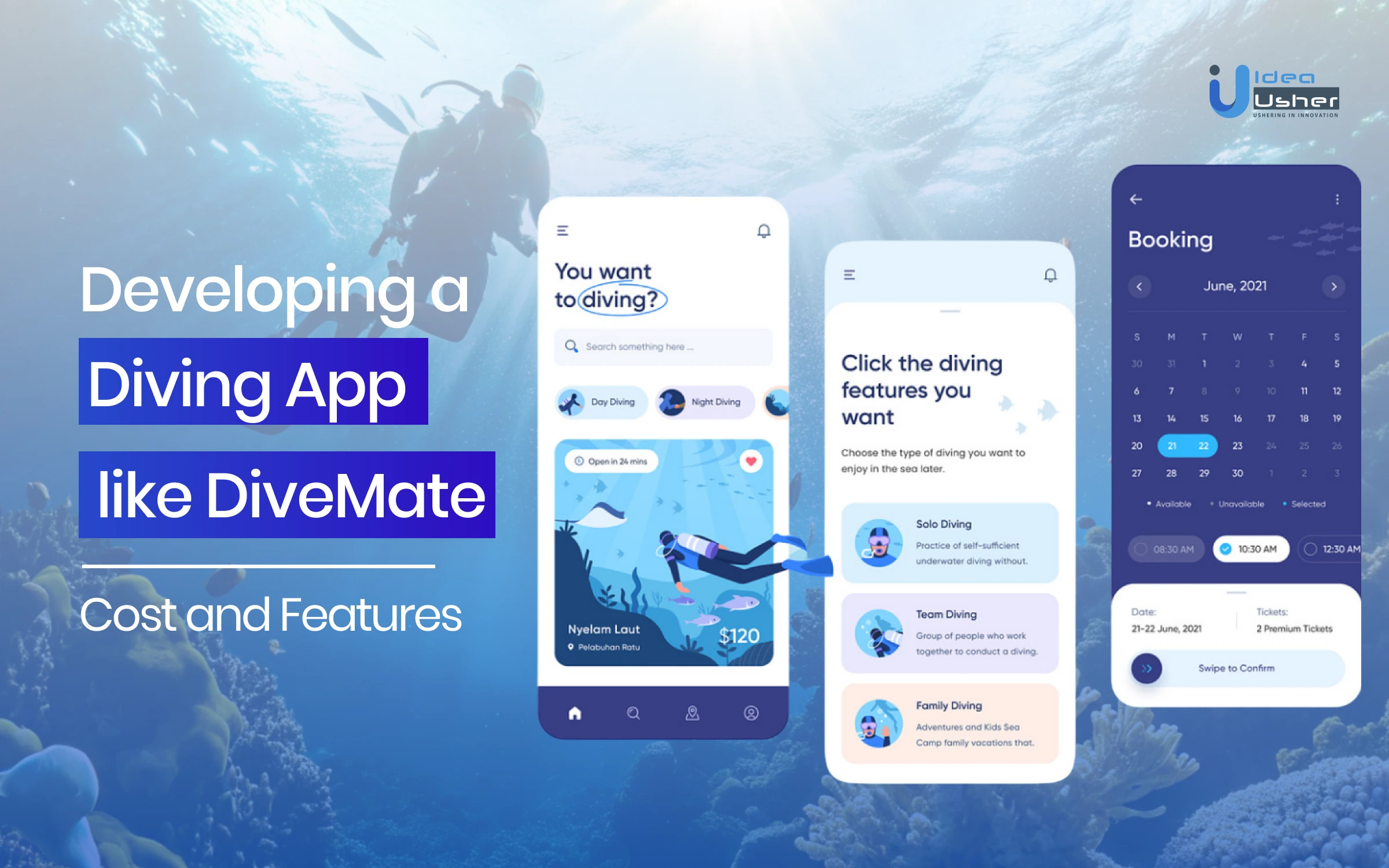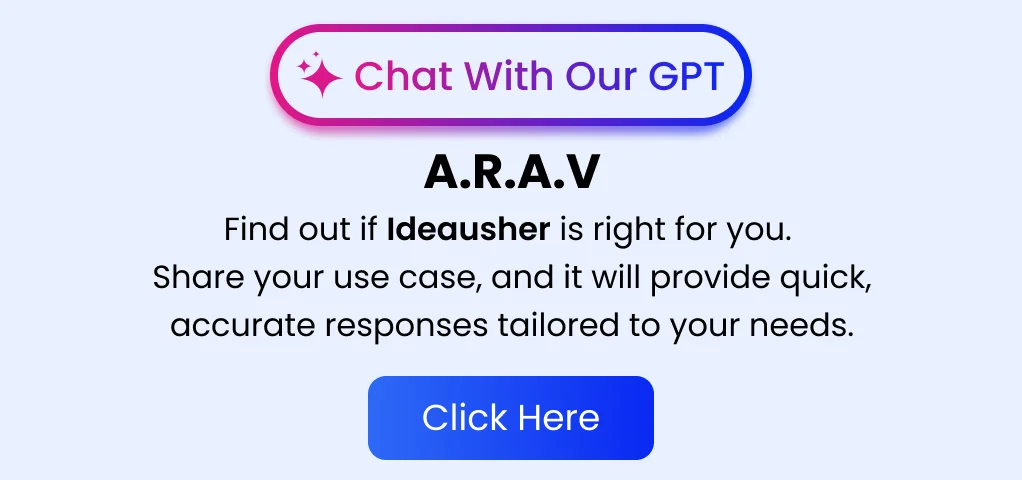Nowadays, people are increasingly turning to technology to enhance their experiences, and divers are no exception. Diving apps like DiveMate have become essential tools for divers at all levels, offering a convenient and all-in-one platform to plan, track, and share their underwater adventures. These apps make it easy to plan dives by allowing users to choose dive sites, check the weather, and calculate dive times. They also help divers log important details like depth, time, and air consumption, making it easier to track their progress and spot patterns in their diving habits.
The diving app market is expected to reach USD 1,358.2 million in 2024. This growth shows that more and more people are using these apps to enhance their diving adventures, making it a great time for businesses to tap into this rising demand!
With these trends, many diving apps are entering the U.S. market. In this blog, we will walk you through how to create a user-friendly diving app like DiveMate, filled with features that will make your app stand out. Let’s dive in and explore how to build something truly unique!
Key Market Takeaways for Diving Apps
Source: AlliedMarketResearch
Thanks to advancements in mobile technology, divers now have easy access to real-time information on dive sites, weather conditions, and marine life. Many apps also incorporate social networking features, enabling divers to connect with a global community, share their adventures, and attract new participants to the sport.
Innovative partnerships and advancements are shaping the future of diving apps. For example, the Virtual Divers International app, in collaboration with Scuba Schools International, allows users to practice diving skills in a simulated environment. This partnership enhances training for beginners and provides advanced simulations for experienced divers, offering realistic, immersive experiences. Apps like Deepblu and DiveMate have formed partnerships with dive shops and equipment manufacturers, making it easier for users to book trips and streamline their dive planning. These integrations support local dive businesses while improving the overall user experience.
Work with Ex-MAANG developers to build next-gen apps schedule your consultation now
Business Model of the DiveMate App
DiveMate, a popular dive logging app, employs a freemium business model with in-app purchases to monetize its offerings. This marine app provides a free base version with core dive logging functionality while offering additional features and capabilities through paid extension packs. This allows divers to access essential features at no cost while providing an opportunity to upgrade to premium features as needed.
Free Base App
The free version of DiveMate offers basic dive logging capabilities, including:
- Manual entry of dive data
- Dive profile display
- Dive site management
- Dive sharing and social features
Extension Packs
DiveMate offers several extension packs that unlock advanced features with a one-time purchase. These include:
- Transfer Pack: Enables direct transfer of dive data from over 170 dive computer models via USB, infrared, and Bluetooth
- Map Pack: Provides access to over 20 online dive site maps and allows for offline map usage
- Data Pack: Unlocks printing capabilities, backup and sync between devices via Dropbox, and sync with PC/Mac programs
DiveMate’s extension packs are priced as one-time purchases, allowing users to access the features on all their Android devices. The current pricing for the extension packs is as follows:
- Transfer Pack: $9.99
- Map Pack: $4.99
- Data Pack: $9.99
DiveMate has been downloaded 1,248 times on the Soft112 platform alone. The app is available in several languages, including English, German, Italian, French, Spanish, Dutch, and Russian, indicating a global user base.
Are Diving Apps like DiveMate Profitable?
Diving apps like DiveMate and others in the market have significant potential for profitability, driven by various revenue streams and a growing customer base. Understanding the customer lifetime value for these apps, along with their revenue potential, provides insight into their financial viability.
Customer Lifetime Value
For diving apps, CLV can be calculated based on subscription fees, user retention rates, and additional revenue from partnerships with dive shops or training organizations.
For example, if a user subscribes to DiveMate’s extension packs at an average price of $9.99 each and purchases two packs over three years, the CLV would be:
CLV = (Price x Number of Purchases) x Average Retention Years= (9.99 x 2) x 3 = 59.94
This calculation suggests that each user could generate approximately $59.94 over their lifetime through direct purchases alone. If we consider additional revenue from affiliate commissions or bookings made through the app, this figure could increase significantly.
Revenue Potential and Examples
Diving apps generate revenue through various channels, including subscriptions, in-app purchases, and affiliate commissions. Here are some examples:
Deepblu
This app offers premium subscriptions ranging from $2.99 to $22.99 annually. With over 110,000 downloads reported, even capturing a small percentage of active users as paying subscribers can lead to substantial revenue. For instance, if 10% of users opt for the yearly subscription at $22.99:
- Revenue from subscriptions = 110,000 x 10% x $22.99 = $252,890 annually.
PADI Adventures
Launched as a digital booking platform for scuba diving activities, PADI Adventures has seen significant engagement with dive shops benefiting from increased visibility and bookings. Reports indicate that dive shops using PADI Adventures have experienced a 20% increase in visibility and a 15% increase in bookings since its launch. Additionally, dive shops can earn referral commissions of around $300 per booking, further enhancing revenue streams.
DiveMate
With its extension packs priced at approximately $9.99 each and similar download numbers to Deepblu, if DiveMate captures around 5% of its users purchasing two packs over three years:
- Revenue potential = 110,000 x 5% x (9.99 x 2) = $109,890 over three years.
Key Features of Diving Apps like DiveMate
Here are some of the key features of DiveMate,
1. Dive Log
A comprehensive dive log is a fundamental feature for any diving app. This functionality allows users to record detailed dive parameters, such as depth, time, temperature, and more. Users can enhance their logs by adding notes, photos, and videos for each dive, creating a personalized record of their underwater experiences.
2. Dive Site Management
Effective dive site management is crucial for divers seeking new adventures. Companies can implement features that allow users to create and manage a comprehensive database of dive sites. This includes adding essential information such as location, current conditions, and other relevant details.
3. Dive Planning
Accurate dive planning is essential for safety and enjoyment. A robust dive planning feature allows users to calculate dive times based on depth and gas mixture. This functionality helps divers understand their limits and plan their dives accordingly.
4. Dive Computer Connectivity
Connecting to dive computers adds significant value to diving apps. This feature allows users to link compatible dive computers to transfer dive data seamlessly directly. Supporting various connection methods, such as USB, Bluetooth, and infrared, enhances versatility and convenience.
5. Nitrox Maximum Operating Depth Calculator
The Nitrox MOD calculator is a vital tool for divers using enriched air. This feature calculates the maximum operating depth for various Nitrox gas mixtures, ensuring divers can dive safely within their limits.
Features That Can Enhance a Diving App like DiveMate
To remain competitive and attract a wider user base, developers should consider incorporating innovative features that go beyond the standard offerings.
1. Real-Time Underwater Navigation
Dive apps can leverage GPS and other navigation technologies to provide real-time underwater navigation, guiding divers to specific dive sites or helping them avoid hazards.
2. Decompression Sickness Risk Assessment
Incorporating advanced algorithms and data analysis, dive apps can assess the risk of decompression sickness based on dive parameters, diver health, and environmental factors.
3. Marine Life Identification
Utilizing AI and image recognition, dive apps can help divers identify marine species, contributing to marine conservation efforts and enhancing the overall diving experience.
4. Dive Site Conditions Monitoring
Dive apps can integrate with sensors and data feeds to provide real-time information on dive site conditions, such as water temperature, visibility, and current strength.
5. Emergency Contact and Assistance
Integrating emergency contact features and links to local dive rescue services can provide peace of mind for divers and their loved ones.
6. Dive Log Analysis and Recommendations
Dive apps can analyze dive logs to provide personalized recommendations, such as suggesting suitable dive sites based on a diver’s experience level, interests, and physical condition.
7. Integration with Dive Equipment
Dive apps can integrate with dive equipment, such as dive computers and gauges, to provide a seamless and comprehensive diving experience.
How Will the App Interact with Dive Computers?
The interaction between a diving app and dive computers is crucial for enhancing user experience and ensuring accurate logging of dive data.
- Many modern dive computers, such as the Suunto D5 and Oceanic’s Bluetooth-compatible models, allow direct pairing with mobile apps via Bluetooth connectivity. This enables automatic syncing of dive logs, ensuring that users can easily transfer data without manual input. Some apps, like Mares App, even allow users to download dive data directly from selected Mares dive computers.
- In addition to Bluetooth synchronization, some diving apps support Wi-Fi syncing, allowing users to back up their dive logs to a desktop computer or cloud storage. This method provides flexibility in accessing dive data across multiple devices and ensures data safety.
For example, Dive Log supports Wi-Fi synchronization and backup to Windows PCs with Diving Log 5.0, and on Mac OS X, it uses Dive Log Manager/Dive Log DT, as well as MacDive. These applications incorporate bi-directional synchronization with their respective native file formats and support downloading a wide range of dive computers.
Development Steps for a Diving App like DiveMate
Here are the development steps for a diving app like DiveMate,
1. Define Your Target Audience and USP
Businesses developing a diving app like DiveMate must begin by identifying their target audience. Companies can choose to cater to recreational divers, professional divers, or even specific niches within the diving community. A clear understanding of the audience helps define the app’s features and focus. Defining the USP is equally important.
2. Deep Dive into Diving Regulations and Standards
Ensuring compliance with diving regulations and standards is crucial for companies building a diving app. Businesses must integrate safety features that adhere to international diving standards, such as those set by PADI or SSI.
3. Leverage Dive Computer Integration
Dive computer integration is a key feature for diving apps. Companies can partner with dive computer manufacturers to allow easy data transfer and synchronization between the app and dive computers.
4. Incorporate Underwater Navigation and Mapping
Businesses developing a diving app must incorporate underwater navigation features to provide users with accurate guidance. Integrating GPS and compass features, even for underwater use, allows divers to stay oriented during their dives.
5. Implement Dive Profile Analysis
Dive profile analysis is a critical feature of any diving app. Businesses should develop algorithms that analyze dive data, assess decompression stops, and track nitrogen buildup in a diver’s system.
6. Offer Dive Buddy Tracking and Emergency Features
Real-time dive buddy tracking is a valuable feature that enables divers to monitor each other’s locations underwater. Businesses can develop this feature to improve diver safety and enhance the social aspect of diving.
7. Consider Underwater Communication
Underwater communication is an emerging feature that companies can explore. By integrating acoustic communication devices, businesses can enable divers to send and receive messages underwater.
8. Optimize for Underwater Use
Optimization for underwater use is essential when developing a diving app. Businesses must ensure that the app’s user interface is designed for visibility, with large, clear elements that are easy to see underwater.
Cost of Developing a Diving App like DiveMate
| Component | Description | Estimated Cost Range |
| 1. Research & Planning | Market analysis, feature prioritization, and target audience research. | $2,000 – $5,000 |
| Market Analysis: Analyzing existing diving apps and identifying opportunities. | $1,000 – $3,000 | |
| Feature Prioritization: Defining key features based on user needs. | $1,000 – $2,000 | |
| 2. Front-End Development | User interface (UI) and user experience (UX) design and development. | $10,000 – $30,000 |
| UI/UX Design: Designing an intuitive and user-friendly interface. | $5,000 – $15,000 | |
| Front-End Development: Coding the app’s interface for iOS and Android. | $5,000 – $15,000 | |
| 3. Back-End Development | Setting up the server infrastructure, database, and APIs for data exchange. | $10,000 – $30,000 |
| Database Design: Managing dive data, user profiles, etc. | $5,000 – $10,000 | |
| API Development: Facilitating data exchange between the front end and server. | $3,000 – $10,000 | |
| Server Setup: Establishing and maintaining server infrastructure. | $2,000 – $10,000 | |
| 4. App Features | Key functionalities such as dive logging, planning, and buddy management. | $10,000 – $25,000 |
| Dive Logging: Recording dive information and syncing with devices. | $5,000 – $10,000 | |
| Dive Planning: Planning dives based on user input and dive site data. | $5,000 – $15,000 | |
| 5. Testing & Quality Assurance | Ensuring the app works well across different devices and platforms. | $3,000 – $8,000 |
| Functional Testing: Testing app features and functionality. | $1,000 – $3,000 | |
| Performance Testing: Ensuring app performance under different conditions. | $1,000 – $2,000 | |
| Security Testing: Securing user data and preventing vulnerabilities. | $1,000 – $3,000 | |
| 6. UI/UX Design Refinement | Refining the design based on feedback and testing results. | $2,000 – $5,000 |
| Design Iterations: Improving design usability and accessibility. | $2,000 – $5,000 |
Total Estimated Cost: $10,000 – $100,000
Diving apps, such as DiveMate, present unique development challenges compared to other types of mobile applications. Here are four factors that are specifically relevant to the development of diving apps:
Underwater Navigation and Mapping
Accurate underwater navigation and mapping require specialized algorithms, data sources, and hardware integration. This can increase development complexity and costs, as it involves factors like GPS signal limitations underwater, compass calibration, and integration with depth sensors.
Dive Profile Analysis
Analyzing dive profiles, calculating decompression stops, and providing safety alerts necessitate advanced algorithms and a deep understanding of diving physiology. This can require significant research and development efforts.
Emergency Features
Incorporating emergency features like SOS signals, dive buddy tracking, and underwater communication presents unique challenges due to the specific requirements of diving environments.
Dive Computer Integration
Integrating with various dive computer models and protocols can increase development complexity and costs. This involves ensuring compatibility, data transfer reliability and addressing potential security concerns.
Tech Stacks Required to Develop a Diving App like DiveMate
Here are the important tech stacks required to develop a diving app like DiveMate,
1. Dive Data Processing
Effective dive data processing is essential for any diving app, including DiveMate. Companies can utilize libraries such as DiveLog, DiveComp, and DiveBuddy to manage dive-specific data efficiently. These libraries offer functionalities to handle various dive data formats and calculations, which are crucial for accurate dive logs.
2. Decompression Algorithm Implementation
Implementing robust decompression algorithms is vital for diver safety. Companies can leverage established libraries, including Haldane’s algorithm and Bühlmann’s algorithm, to ensure accurate decompression calculations.
3. Dive Site Database
A comprehensive dive site database is fundamental for any diving application. Businesses can either create custom databases or integrate with existing ones, such as DiveBuddy or DiveSpot. Employing geospatial data structures allows for efficient location-based searches, ensuring users can easily find relevant dive sites.
4. Dive Profile Visualization
Visualizing dive profiles is crucial for divers to understand their underwater experience. Companies can use libraries like Dive Profile Viewer and Dive Chart to create interactive visualizations that display depth, time, and decompression stops.
5. Dive Planning Tools
Incorporating effective dive planning tools is essential for safety and preparedness. Companies can implement algorithms for bubble time calculation and repetitive dive planning. Integrating these tools with existing dive planning software allows users to plan their dives efficiently.
6. Dive Gear Management
Managing dive gear effectively is critical for divers to ensure their equipment is in top condition. Businesses can develop custom databases to track dive gear, maintenance schedules, and certifications.
Most Successful Business Models for Diving Apps like DiveMate
Diving apps have gained significant popularity among divers, providing essential tools for logging dives, planning trips, and connecting with the diving community. Here are some successful business models that have emerged in this niche, exemplified by various apps like DiveMate, Deepblu, and Subsurface.
1. Freemium Model
This approach attracts a large user base quickly, as users can try the app without any financial commitment.
For example, Deepblu operates on a freemium model where app users can access basic functionalities for free, such as logging dives and sharing experiences. However, premium features, such as advanced dive planning tools and exclusive content, require a subscription. This model has proven effective; Deepblu reported over 1 million downloads within two years of launch, indicating strong user engagement and retention through its premium offerings.
A study found that 80% of users who start with a freemium app eventually convert to paid subscriptions after experiencing the value of premium features.
2. Subscription-Based Model
A subscription model charges users a recurring fee (monthly or annually) for access to the app’s full features and content. It provides a steady revenue stream and encourages continuous updates and improvements.
For instance, Subsurface utilizes this model by offering cloud storage and syncing capabilities for a subscription fee. Users can store their dive logs securely and access them across multiple devices, enhancing convenience.
Subscription-based services have seen a growth rate of over 20% annually in the software industry, reflecting increasing consumer preference for ongoing access over one-time purchases.
3. Advertising Model
Apps using this model provide free access to users while generating revenue through advertisements. This approach is viable for apps with large user bases where advertisers seek to reach niche markets.
DiveMate, while primarily a dive logbook app, incorporates advertising from dive shops and equipment manufacturers within its platform. This not only helps keep the app free but also connects users with relevant products and services in the diving community.
A report indicated that mobile advertising revenue can easily surpass $300 billion by 2025, showcasing the potential profitability of this model when paired with high user engagement.
4. Marketplace Model
This model connects divers with service providers (like dive shops or instructors) through the app, taking a commission on transactions made through the platform.
For instance, Deepblu also exemplifies this model by allowing users to book dives directly with local dive shops via the app. By facilitating these transactions, Deepblu earns commissions while providing added value to both divers and businesses.
The global online marketplace for travel-related services can reach $1 trillion by 2025, indicating substantial demand for platforms that connect consumers with service providers in niche markets such as diving.
Conclusion
Diving apps like DiveMate offer significant benefits for both common people and businesses. For individuals, these apps provide essential tools for planning, tracking, and analyzing diving experiences, enhancing safety and enjoyment. Companies can capitalize on the growing popularity of diving by developing similar apps and generating revenue through various channels. This includes in-app purchases, premium subscriptions, advertising, partnerships with dive centers, and data monetization.
Looking to Develop a Diving App like DiveMate?
Idea Usher, with over 500,000 hours of coding expertise in the field, is your ideal partner for creating a cutting-edge diving app. Our team of skilled developers specializes in crafting intuitive and feature-rich mobile applications tailored to the specific needs of divers. We can help you build a comprehensive app that incorporates essential features like dive logging, planning, buddy management, and underwater navigation while ensuring seamless integration with dive computers and adherence to industry standards. Let us leverage our technical prowess to bring your diving app vision to life.
Work with Ex-MAANG developers to build next-gen apps schedule your consultation now
FAQs
Q1: How to develop a diving app?
A1: Developing a diving app involves a comprehensive approach that includes defining your target audience, conducting market research, designing a user-friendly interface, developing core features, integrating with dive computers, incorporating multimedia, building a robust backend, thoroughly testing, and launching with ongoing iteration based on user feedback.
Q2: How diving apps make money?
A2: Diving apps can generate revenue through various channels, including in-app purchases (e.g., premium features, additional data), subscriptions (for access to premium content or advanced features), advertising (display ads, sponsored content), partnerships with dive centers or equipment manufacturers, and data monetization (selling anonymized user data to third parties).
Q3: What are the features of the diving app?
A3: Diving apps typically offer a range of features to enhance the diving experience. These may include dive logging, planning and tracking, dive buddy management, underwater navigation and mapping, dive profile analysis, emergency features, integration with dive computers, and access to a community of divers.
Q4: How long does it take to develop a diving app?
A4: The development timeline for a diving app like DiveMate can vary significantly depending on factors such as the complexity of features, the size and experience of the development team, and the iterative nature of the design process. While a basic app might be developed in a few months, incorporating advanced features like underwater navigation, dive profile analysis, and emergency functionalities can extend the timeline to several months or even a year.























